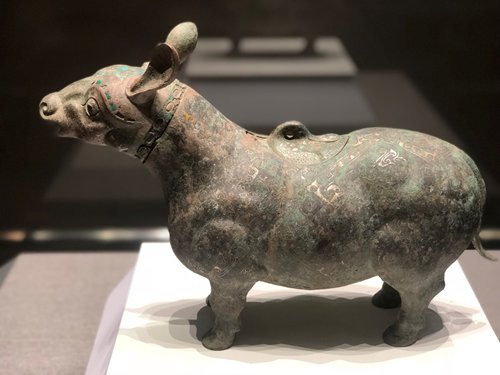For a city, museums are windows to the past. Boasting 96 public and private museums, the city of Zibo in East China's Shandong Province is able to provide a look into history that rivals any major city in the world. Roughly 2,000 years ago, the city used to be one of the largest urban centers in Asia. The capital city of the Qi Kingdom during the Spring and Autumn (770BC-476BC) and Warring States (475BC-221BC) periods, Zibo played an important role in Chinese history.
The Linzi district is the center of the city's museum community. It is here that you can find the Qi Capital Culture City, which is home to more than 20 museums, including the city's three heavyweight museums - the Qi Heritage Museum, the Chinese Ancient Cart Museum and the Linzi Football Museum.

World's earliest form of 'soccer'
It's no secret that England was the birthplace of the game known as modern soccer. However, few Westerners have heard of cuju, an ancient Chinese game that bore a remarkable similarity to modern soccer. Dating back to the 3rd century BC, Cuju has been recognized by FIFA as the earliest known form of soccer. In fact, visitors to the museum have the chance view a certificate signed by former FIFA president Sepp Blatter.
Walking into the Linzi Football Museum feels like traveling back in time. On display are various mentions of cuju from various ancient historical works such as the more than 2,000-year-old histories Strategies of the Warring States and Records of the Grand Historian. As far as we know, cuju was born as a form of exercise and training for military cavaliers and then gradually developed into a game meant purely for fun.
The sport reached its peak during the Tang (618-907) and Song (960-1279) dynasties. It is said that Chang'an, the Tang capital, was filled with various cuju pitches from rich families' backyards to the emperor's palace. Female cuju teams were also formed during this time. With the social and economic developments of the Song Dynasty, professional cuju players became very popular.
One highlight that visitors should not miss are the cuju reenactments held on the museum grounds every day.

'Great Duke of Qi'
Reviewing the history of the Qi state, Jiang Taigong, or Jiang Ziya, is a name that shouldn't be overlooked. The first marquis of Qi, Jiang was bestowed this position due to his great contributions helping the kings Wen and Wu of the Zhou Dynasty (1046BC-256BC) overthrow the Shang Dynasty (C.1600 - 1046BC). The starting section of the Qi Heritage Museum lays out how Jiang helped the two Zhou kings and later received the title of "Great Duke of Qi."
According to museum curator Ma Guoqing, the museum introduces the origins, history and development of the Qi Kingdom as well as its cultural heritage and folk customs through more than 3,000 exhibits. One of the most important exhibits on display is a national treasure known as the Xi Zun, a Warring States Period bronze vessel unearthed in the province's Shangwang village. Xi refers to an animal sacrifice used in ancient rites, while zun is a type of wine vessel, as such the ox-shaped bronze was most likely used during important sacrificial rituals.
Additionally, the museum also has sections introducing two of China's most famous military minds: Sun Tzu, the well-known Spring and Autumn Period military strategist who penned The Art of War, and the later Warring States military strategist Sun Bin, who also wrote a similar treatise on war known as Sun Bin's Art of War. Both famous commanders were from Qi.

Wheels of history
Wheeled vehicles, from military chariots to horse carts used by farmers, played an integral role in the development of China. For those who wish to know more about the impact these vehicles played, the Chinese Ancient Cart Museum is the perfect place for you.
The entire museum is built over one of the top 10 archeological discoveries of 1990: the Funerary Horse Pits.
The core of the museum encompasses the original site where two burial pits belonging to ancient noble families were discovered during the construction of a highway.
Some 32 meters long and five meters wide, Pit No.1 of the Funerary Horse Pits, contains the preserved remains of 32 horses and 10 chariots. Among the 10, one chariot has larger wheels which indicates that it was meant for supply and gear transportation, while the other nine were meant to be rode into battle. Entering the display area, visitors can easily see that each horse was carefully decorated with cooper, bones and shells.
The No.2 pit is eight meters long and three meters wide and contains the remains of three chariots and six horses.
The museum also delves into the history and evolution of Chinese carts, such as the bullock, elephant and camel carts, starting with the Shang Dynasty and ending with the last Chinese dynasty, the Qing (1644-1911).


















































